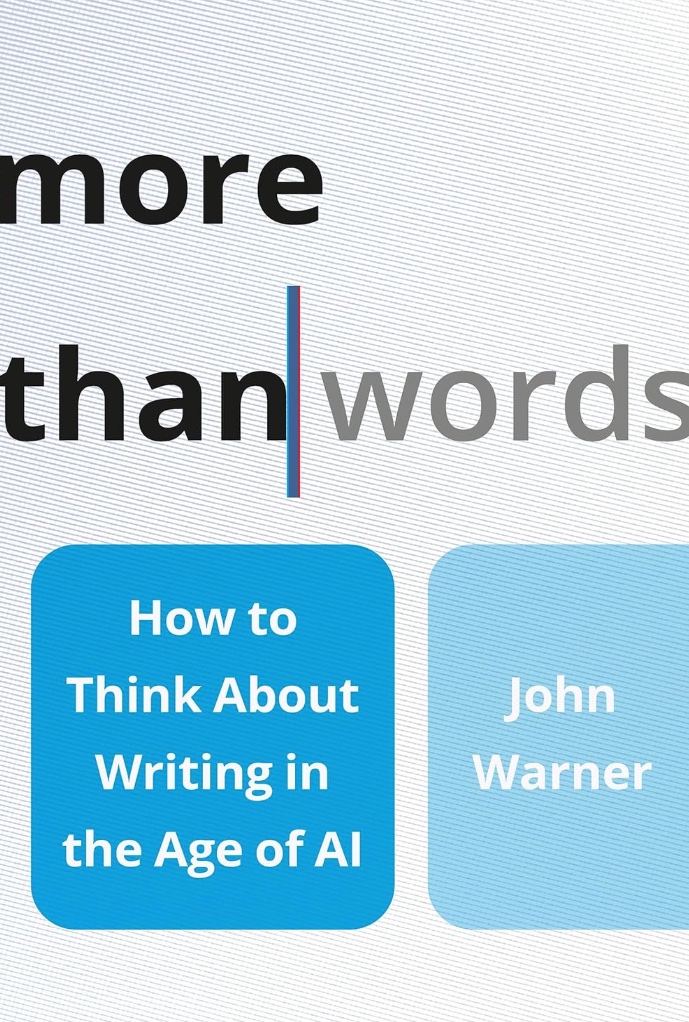
The arrival of generative AI on top of algorithmic social media can feel like a pandemic on top of a pandemic for overwhelmed parents, educators, writers, knowledge workers, or anyone trying to work thoughtfully with language.
As someone who wears all those hats, I’m constantly struck by how thoughtlessly we’ve charged into an AI-saturated world. Influencers teach teens to outsource their homework to bots, colleges offer their incoming students “personalized” GPTs, and executives look to replace needy human workers with bots. Seemingly, any time I open an app, some pushy new feature wants to help compose, summarize, or generate more … stuff.
To what end?
John Warner’s More than Words: How to Think about Writing in the Age of AI offers an immensely helpful framework by starting with a foundational question: What is writing actually for? If the point is the end product—grammatically and syntactically correct prose—then outsourcing the difficult work of writing sounds great. But if there’s value in the process of struggling to articulate thoughts, then outsourcing our writing is outsourcing an essential part of our humanity.
That might sound lofty to someone just looking for help composing an email or churning out a homework essay. But in a flood of product releases and breathless hype, Warner argues, starting with first principles is essential.
“Rather than seeing ChatGPT as a threat that will destroy things of value,” he says, “we should be viewing it as an opportunity to reconsider exactly what we value and why we value those things.”
As a longtime writing teacher and a columnist at Inside Higher Ed and the Chicago Tribune, Warner is well-positioned to consider how generative AI intersects with art, education, politics, and so much else. Across chapters with refreshingly simple titles—“Only Humans Write,” “Writing Is Thinking,” “Writing Is Feeling,”—he argues that what large language models like ChatGPT do is fundamentally not writing but copy generation, not intelligence but automation. At their core, LLMs are probability machines, attempting to guess the “right” word in a sequence, one by one. Tech companies like OpenAI ask us to anthropomorphize their products as “research assistants,” “copilots,” or “teammates.” But these metaphors do more to obscure than to clarify.
When it comes to education, Warner situates AI in a long history of promises to improve classroom learning by automating it: mechanized teaching machines in the 1920s, B.F. Skinner’s pigeon-training devices applied to children in the 1950s, Massively Open Online Courses (MOOCs), ed-tech startups like Knewton, and Khan Academy’s recent promises of AI tutors. All of these have been more effective at attracting seed funding than transforming the stubbornly relational work of teaching. It’s not lost on Warner that it’s nearly always male engineers and entrepreneurs promising to “solve” the female-dominated teaching profession through technology.
In contrast, he tells the story of his third-grade teacher, Mrs. Goldman, instructing her class to write a list of instructions for making a peanut butter and jelly sandwich—and then follow it. Third-grade John discovered that he had forgotten to mention a knife when he found his hand knuckle-deep in a jar of peanut butter:
In that moment, I am a young person having fun while learning about writing, experiencing a lesson I have never forgotten, that there is an intention and audience on the other side of things you write, so spending time considering them before you start writing is only sensible.
Mrs. Golden snapped a photo, which he uses as his newsletter avatar:
ChatGPT can generate sandwich instructions, but it cannot recreate that moment of stickiness and delight.
But what about forms it does seem to have mastered, like the five-paragraph high school essay? Warner wrote a whole previous book attacking this form: Why They Can’t Write: Killing the Five-Paragraph Essay and Other Necessities. He argues that it serves none of the true purposes of writing. It doesn’t inform, persuade, or motivate others; it rarely leads to self-discovery or meaningful expression of feelings. Its sole virtue is that it’s easy to grade. It teaches students that writing is jumping through a series of arbitrary hoops—a transactional model of education. No wonder they hate it. ChatGPT’s ability to imitate the template is proof of the form’s uselessness, not the machine’s intelligence.
That leads to one of Warner’s key rules of thumb: If a form can be effectively created by generative AI, it probably doesn’t need to exist in the first place. Send me your AI-generated blog posts and marketing emails and meeting summaries, and podcasts, and I’ll have my AI assistant summarize and file them away for me. Meanwhile, server farms somewhere buzz with the colossal energy and water usage of it all.
As far as kids avoiding their homework, same as it ever was, right? Rather than trying to suppress access to AI tools, whack-a-mole style, Warner advises writing assignments that invite curiosity, struggle, and discovery—assignments that students won’t want to miss out on. Maybe that’s naive, but it also seems better than a surveillance-only approach to kids and technology.
Warner has less to say about how ChatGPT might help second-language learners or those who find writing in professional contexts to be genuinely stressful—I wish he explored this further. He does find generative AI to be somewhat useful for research, summarizing long documents, or generating suggestions for improving a draft. So do I. But that’s hardly world-changing technology.
Part of the challenge of thinking about AI is that the short-term and long-term impacts may be very different. In the short term, what seems most certain is a lot more vapid content being churned out into a world that doesn’t need any more. And it’s all coming, aggressively, from the tech titans who lined up for Trump’s second inauguration. To be candid, I find it difficult to separate my feelings about the technology from my intense dislike of the billionaires pushing it at us. The challenge for me is to stay open-minded regardless.
That personal insight, by the way, is one I never would have reached if I’d outsourced this review to ChatGPT.
We haven’t even broached the potential impacts on labor markets, our already-degraded news environment, or generations of kids who might never learn to write without automated assistance.
As a parent, that’s where the issue touches home for me. Anyone who’s cared for students through the Covid lockdown era knows the foolishness of launching technology at our kids that we don’t understand ourselves.
Sure, they need to learn digital literacy at some point. That should come after literacy literacy.
Warner offers the analogy of orange juice and Tang. Tang is delicious, but without tasting the real thing, you don’t know what you’re missing. Students who use ChatGPT prompts to generate passable essays, and move on, and repeat, into college, into adulthood, might never learn what it feels like to express their thoughts through language.
My fear is that AI will become another engine of inequality, with bespoke humanistic education for the well-to-do and prompt-engineering training for everyone else. Warner shares that concern:
Deep down, I believe that ChatGPT by itself cannot kill anything worth preserving. My concern is that out of convenience or expedience, or through carelessness, we may allow these meaningful things to be lost or reduced to the province of the select few rather than being accessible to all.
His framework for action is simple and useful: “Resist, renew, explore.” The thing to resist is technological determinism—the idea that we must passively accept everything Big Tech promotes. It’s up to us, collectively, to decide if we want this stuff in our schools, homes, and lives.
“Renew,” for Warner, means embracing whatever gives us meaning and sustenance regardless of technology. He draws on Wendell Berry’s distinction between creatures and machines in Life Is A Miracle. Creatures need each other. Creatures need the natural world. “The fact is that we are embodied,” says Warner. “We live our lives through a series of experiences rooted in a community of fellow humans.” That’s not something to escape but to cherish.
Finally, he says, keep exploring the potential value of new technology. Choose guides for your exploration, but choose them wisely. “It is important not to mistake a guide for an all-knowing sage,” says Warner, “… letting weirdos like Joe Rogan or Jordan Peterson, or even non-weirdos like Brené Brown, substitute for your own judgment.”
I found Warner through an excellent episode of the podcast Search Engine, which I’ve found to be a helpful guide to digital culture. That in turn led me to Warner’s Substack and eventually to this book, which pointed me to yet more intriguing guides to AI (Marc Watkins, Emily Bender, Ethan Mollick, Paris Marx, and others).
Is it overwhelming to try to keep up with this stuff? Sure. But we’re not alone. What I look forward to most in writing this piece is discussing it with others. I want to hear what you’re worried about regarding AI, what you’ve figured out, and what you haven’t. We’re in this together. Regardless of tech, regardless of hype, that hasn’t changed.


5 Responses
I’ll have to read the book. I’ve made my living as a writer for four decades, and AI has been on my radar for a while now. What struck me in this essay was the question: What is writing actually for? And closely tied to it: What is the value of struggling to articulate thoughts?
I don’t disagree with the premise. But when you write for a living (especially through the lens of the sender-receiver model) writing becomes about more than just internal struggle. There’s a reader on the other end. Will the message break through? Will it land? Will it be understood?
Those are equally vital questions. And when it comes to answering them, AI has a lot to offer.
As a solo writing business owner, I’ve come to rely on AI, not just for research and summaries, but for first-draft feedback and final edits. It can learn my voice. It can shape my style. With the right prompts, it can even make my writing better—for the reader.
I see plenty of writers dismissing AI or insisting it could never replace a human. But if I were just starting out, I’d be diving in headfirst. AI isn’t going away. It will replace many writers. Not all, but many.
So, I’ll read the book, and I’ll keep learning. Because if AI can help me write more clearly, more effectively, and more powerfully, it’s not just a threat. It’s a tool. And a smart writer knows how to use their tools.
(edited and significantly improved by ChatGPT)
For folks interested in AI, this piece might be worth a look (the author, Christopher Penn is a smart and advanced thinker on the topic): https://almosttimely.substack.com/p/almost-timely-news-revisiting-the
Thanks for this fantastic and thought-provoking review. As someone who wears a lot of similar hats, it’s given me a lot to chew on, especially at the start of a new school year.
With the invasion of ChatGBT into my world, I have an increased respect for footnotes. I want to be able to access the sources. Books carry more weight than URLs.
But I also appreciate the Reformed Journal for informing me about John Warner’s recently published book and for daily providing thoughtful essays such as Johnathan Hiskes’ review of that book.